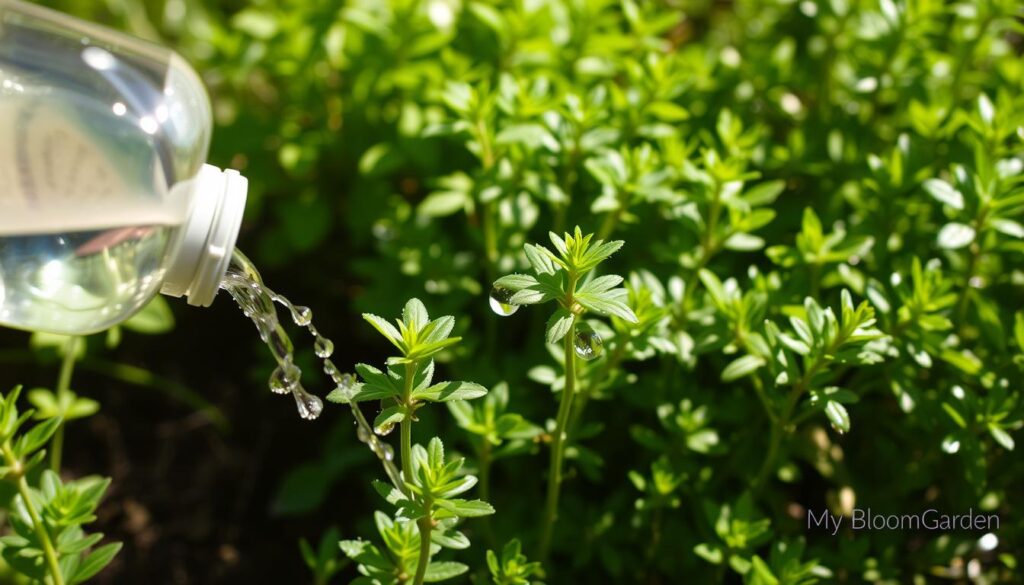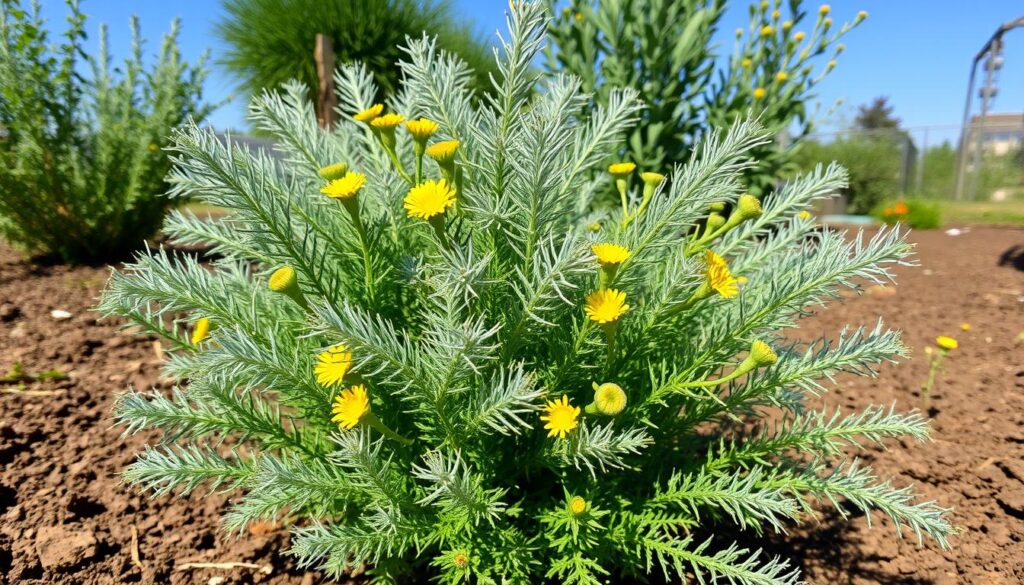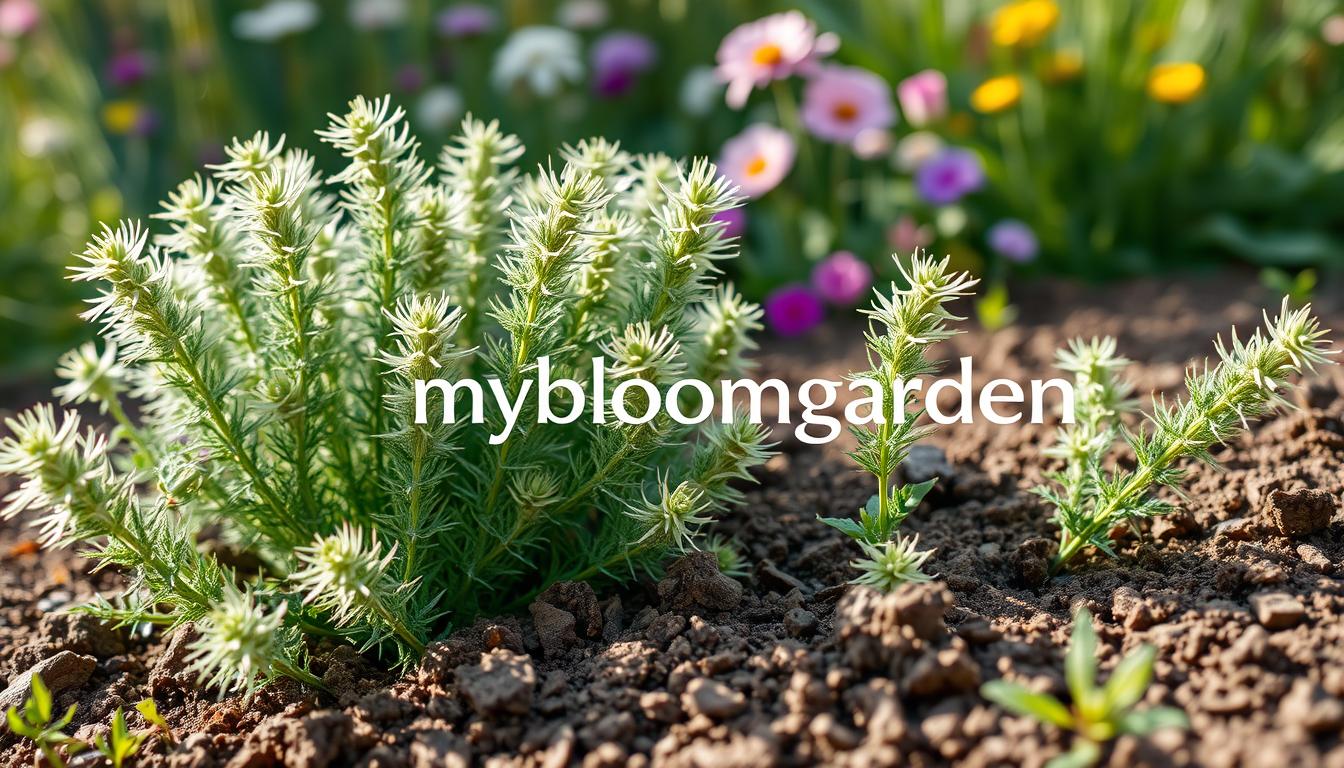I’ve always been drawn to wormwood, also known as Artemisia absinthium. This plant is not just fascinating but also has a rich history. It’s a great choice for any garden, and I’m here to guide you through it.
Planting wormwood is a rewarding experience that can change your garden. This guide is for both experienced gardeners and newcomers. We’ll cover everything from the plant’s unique traits to the best growing conditions. You’ll learn how to make your wormwood thrive with beautiful leaves and a lovely scent.
Table of Contents
Understanding Wormwood: An Introduction to Artemisia Absinthium
The artemisia plant, also known as absinthe wormwood, has a long history. It’s valued for its health benefits and unique taste. This makes it interesting for gardeners and herbalists.
Historical Uses and Significance
Wormwood, or Artemisia absinthium, has been used in medicine for thousands of years. The ancient Egyptians, Greeks, and Romans used it in their remedies and rituals. In the 18th and 19th centuries, it became famous as the main ingredient in absinthe, known as “the green fairy.”
Different Varieties of Wormwood
- Common wormwood (Artemisia absinthium)
- Silver wormwood (Artemisia ludoviciana)
- Roman wormwood (Artemisia pontica)
- Southernwood (Artemisia abrotanum)
Benefits of Growing Wormwood
The artemisia plant has many benefits for gardeners today. It’s tough, can handle drought, and grows well in sunny spots. Its strong scent can also keep insects away, protecting other plants in your planting artemisia garden.
“Wormwood is a versatile and fascinating herb that has captured the imagination of people throughout history. Its potential benefits in the garden and beyond make it a valuable addition to any green-thumbed enthusiast’s repertoire.”
Ideal Growing Conditions for Wormwood Plants
Planting wormwood, or artemisia absinthium, needs the right growing conditions for success. This hardy plant does well in certain environmental factors. It’s a great choice for your garden.
Lighting and Temperature Requirements
Wormwood plants love full sun, needing at least 6 hours of direct sunlight daily. They can handle some shade, but more sun is better. They grow best in warm, dry climates. The best temperature range is 60°F to 85°F (15°C to 29°C).
Soil and Drainage Considerations
- Wormwood needs well-draining, nutrient-rich soil. Heavy, clay-based soils can cause waterlogging and disease.
- Soil pH should be slightly alkaline, between 6.5 and 8.0, for the best growing conditions.
Good drainage is key for wormwood plant health. They do well in areas with good air circulation and no standing water.
“Wormwood is a resilient and versatile plant that can adapt to a variety of garden conditions, but understanding its preferred growing environment is the key to success.”
By giving your wormwood plants the right sunlight, temperature, soil, and drainage, you create perfect growing conditions. Spending time learning these needs will reward you with a healthy and abundant harvest of this interesting herb.
Soil Requirements and Preparation for Artemisia
When growing wormwood plants (Artemisia absinthium), soil matters a lot. Preparing the soil right is key for your plants to do well in your garden.
Testing Soil pH Levels
First, test your soil’s pH levels. Wormwood likes slightly acidic soil, with a pH of 6.0 to 7.5. Use a soil testing kit to check your soil’s pH and adjust it if needed.
Soil Amendment Techniques
- If your soil is too alkaline, add sulfur or compost to lower the pH.
- For clay soils, mix in compost or aged manure to help with drainage and aeration.
- Peat moss or vermiculite can help sandy soils hold moisture and nutrients better.
Drainage Considerations
Wormwood plants need well-drained soil. If your garden drains poorly, consider raising beds or installing a French drain. Good drainage prevents root rot and diseases that harm Artemisia absinthium.
“Wormwood is a hardy, drought-tolerant plant, but it will not tolerate wet, poorly drained soil.”
By testing and amending your soil, you’re ready for a successful wormwood planting. Good soil preparation means your Artemisia absinthium plants will grow strong and healthy.
When and Where to Plant Wormwood
Planting wormwood, also known as Artemisia absinthium, needs careful thought. It’s a perennial herb that grows best in certain conditions. These conditions greatly affect its growth.
The best time to plant wormwood is in the spring or fall. These seasons offer the right mix of temperature and moisture. It’s important to plant when the soil is easy to work with and frost is gone.
Selecting the Right Spot
Wormwood loves sunny spots with well-draining soil. Look for a place that gets at least 6 hours of direct sunlight daily. It also does well in areas with good air flow. This helps prevent moisture buildup and diseases.
- Make sure the soil drains well to avoid waterlogging.
- Stay away from areas with a lot of foot traffic or where other plants might compete.
- Think about how big the wormwood will get and leave enough space around it.
Knowing when and where to plant wormwood sets you up for success. You’ll get a great harvest from your efforts.
“Wormwood is a versatile and hardy plant that can thrive in a variety of garden settings, but it requires specific care and attention to reach its full potential.”
Steps for Planting Wormwood Successfully
Planting wormwood, also known as Artemisia absinthium, can be very rewarding. It’s a great addition to any garden. Let’s look at the key steps to plant wormwood successfully in your garden.
Seed Starting Methods
Starting wormwood from seed is a good way to begin. Begin by sowing seeds indoors 6-8 weeks before the last frost. Cover the seeds lightly with soil and keep the soil moist until they germinate. This usually takes 14-21 days.
Once the seedlings have their first true leaves, they’re ready to be transplanted.
Transplanting Guidelines
When it’s time to move your wormwood seedlings outside, pick a sunny spot with good drainage. Carefully remove the plants from their pots, making sure not to damage the roots. Then, plant them in the garden bed at the same soil level as before.
Water well to help the plants settle in their new home.
Spacing Requirements
- Wormwood needs enough space to grow well. Space your artemisia 18-24 inches apart, with rows 2-3 feet apart.
- This spacing helps with air flow and prevents overcrowding, which can cause disease and slow growth.
- Think about how big your wormwood plants will get when deciding on spacing.
By following these steps, you’ll be on your way to a thriving wormwood garden. Enjoy the unique qualities of this plant and the benefits it brings to your garden.
Watering Requirements and Schedule
Understanding how to water your wormwood or artemisia plant is key. Wormwood, or Artemisia absinthium, likes consistent but not too much water. The right amount of water is crucial for your garden’s health.
Soil moisture is important for wormwood. It prefers soil that drains well but isn’t too dry or wet. The soil should be slightly moist to help the roots absorb water.
- Water your wormwood 1-2 times a week when it’s growing well. Give it about 1 inch of water each time.
- If it’s hot or dry, you might need to water more often. This keeps the soil moist.
- Don’t overwater. Wormwood can get root rot if the soil is too wet.
The water needs of wormwood can change. This depends on the weather, soil, and how old the plant is. Watch your plants and adjust the watering to keep them healthy.
“Proper watering is essential for the health and longevity of your wormwood plants. Striking the right balance is key to a thriving artemisia plant in your garden.”
By following these tips and sticking to a watering schedule, your wormwood will grow well. It will add beauty and fragrance to your garden.

Essential Maintenance and Care Tips
Keeping your wormwood plant (Artemisia absinthium) healthy is key. This includes pruning, fertilizing, and preventing diseases. Let’s look at how to make sure your plant thrives.
Pruning Techniques for Wormwood Plants
Pruning is crucial for a bushy wormwood plant. Prune in early spring, before new growth. Use sharp shears to cut just above leaves or buds. Don’t cut into woody stems.
Trimming in the growing season keeps the plant bushy. This encourages denser foliage.
Fertilization Guidelines for Artemisia Absinthium
Wormwood plants are easy to care for. A balanced, slow-release fertilizer helps. Apply it in early spring, following the instructions.
Don’t over-fertilize. Too much can make the plant weak and attract pests and diseases.
Preventing Diseases in Wormwood Plants
- Watch for disease signs like wilting or discolored leaves.
- Ensure good air circulation by spacing plants.
- Water at the base to avoid wetting leaves.
- Remove sick plant parts quickly to stop disease spread.
- Use organic fungicide if needed for fungal issues.
Follow these tips to keep your wormwood plant healthy. Proper pruning, fertilizing, and disease prevention are vital. They ensure your artemisia absinthium plant thrives.
Companion Planting with Artemisia
Planting wormwood plants, or Artemisia absinthium, can be a smart garden move. It’s about growing plants together for mutual benefits. This makes your garden healthier and more productive.
Artemisia is great at keeping pests away. Its strong smell can chase off aphids, spider mites, and even rabbits. By placing wormwood plants wisely, you can protect your garden from harm.
Artemisia also helps plants that like dry, poor soil. Its deep roots improve soil drainage and air. This is good for plants like lavender, rosemary, or sage.
Here are some good plants to pair with wormwood:
- Roses – Artemisia keeps aphids and pests away from roses.
- Tomatoes – Wormwood scent repels tomato hornworms and other pests.
- Cabbage and Brassicas – Artemisia fights off cabbage worms and other insects.
- Fruit trees – Wormwood around fruit trees keeps rodents and insects away.
But, artemisia can be too strong for some plants. It might take over and compete for resources. Make sure to space wormwood plants carefully to avoid problems.
“Companion planting with wormwood is a great way to create a more balanced and resilient garden ecosystem.”
Knowing the good and bad of artemisia in your garden can be helpful. It lets you use this plant to make your garden better and more lively.
Harvesting and Storing Wormwood
Growing the [artemisia absinthium] wormwood plant in your garden offers more than just its unique scent and taste. It also brings medicinal benefits. To get the most out of this herb, learning how to harvest and store it is key.
Best Time for Harvesting
The best time to pick [wormwood plant] is in late summer or early fall. This is when its essential oils are strongest. The exact time can change based on your area’s weather and soil.
Proper Storage Methods
After you’ve picked your [planting wormwood], it’s important to store it right. Start by cleaning the leaves and stems well. Remove any parts that are damaged or look off.
Next, hang the wormwood upside down in a cool, shaded spot. This helps it dry out.
- When the leaves are dry, take them off the stems. Put them in airtight containers like glass jars or bags.
- Keep these containers in a cool, dark spot. This helps keep the essential oils and compounds strong.
- To keep the dried wormwood good for longer, you can also freeze it.
By using these harvesting and storage tips, you can enjoy your [artemisia absinthium] wormwood for months. It will keep its flavor and health benefits.

Common Problems and Solutions
Growing the artemisia plant, also known as wormwood, is rewarding for many garden enthusiasts. Yet, wormwood may face some challenges. Let’s look at common problems and find solutions to keep your planting wormwood healthy.
Pest Infestations
One big worry with artemisia plants is pests. Aphids, spider mites, and caterpillars can harm your wormwood. Use organic pest control, like introducing beneficial insects or neem oil, to fight these pests.
Disease Outbreaks
Wormwood plants can get diseases like powdery mildew and root rot. To stop and handle these, follow good garden practice. Keep air flowing, don’t overwater, and remove sick leaves quickly.
Environmental Challenges
Wormwood loves sunny, well-drained spots but can’t handle extreme weather. If your area has harsh winters or dry spells, protect your plants. Mulch around the base or water them when it’s dry.
“Wormwood is a resilient plant, but with a little care and attention, you can overcome the common challenges and enjoy a bountiful planting wormwood harvest.”
By tackling these common issues, your artemisia plant will thrive. It will add beauty and health to your garden practice.
Growing Wormwood in Containers
Did you know you can grow absinthe wormwood (Artemisia absinthium) in containers? It’s a great way to enjoy its unique look and smell, even in small outdoor areas. Planting artemisia in pots is a great option for those with limited space.
Container Selection Tips
Choosing the right pot is key for growing wormwood in containers. Look for a container that’s at least 12 inches wide and deep. This size allows the plant to spread out.
Make sure the pot has good drainage. Terracotta or well-draining plastic or resin pots work best.
Special Care Requirements
- Soil: Use a well-draining, nutrient-rich potting mix for herbs and vegetables.
- Sunlight: Wormwood loves full sun. Place the container in a spot with at least 6 hours of direct sunlight daily.
- Watering: Water when the top inch of soil feels dry. Avoid overwatering, as wormwood prefers dry soil.
- Pruning: Regular pruning helps keep the plant bushy and healthy. Cut off any dead or damaged leaves.
With the right container, soil, and care, you can enjoy the planting artemisia on your patio or balcony. It’s a rewarding and space-saving choice for any gardener, whether you’re new or experienced.
Conclusion
Planting wormwood, also known as Artemisia absinthium, can be very rewarding for gardeners. This herb has a unique smell and looks great. It also helps control pests and is used in herbal remedies.
This guide will help you grow wormwood in your garden. You’ll learn about the best conditions and how to care for it. Each step is important for your plants to thrive.
Wormwood can be a standout plant or fit well into your garden design. Its special qualities make it a great choice. Start exploring wormwood and see how it changes your garden.

